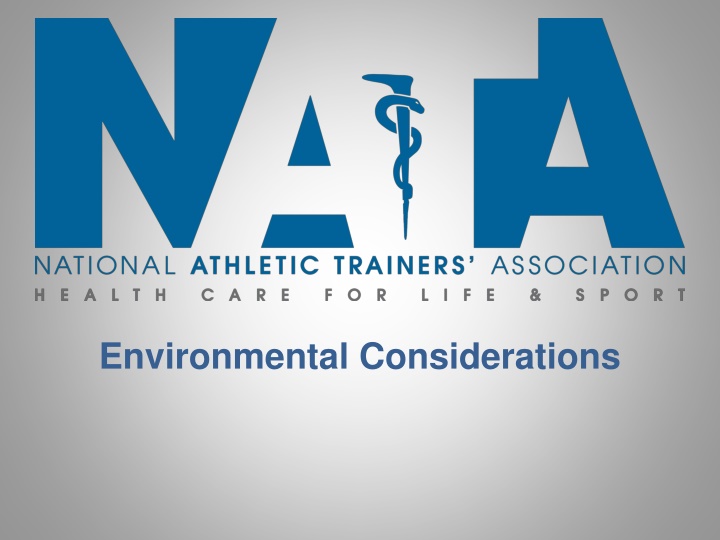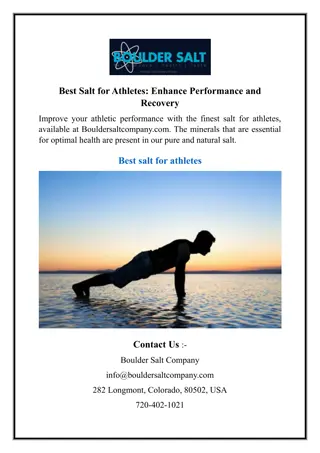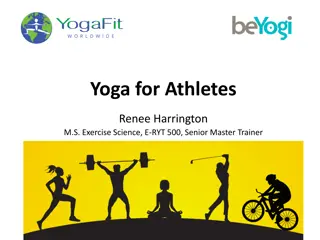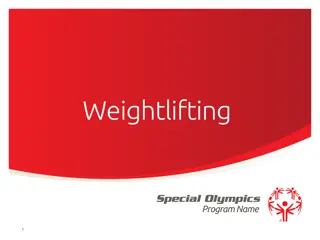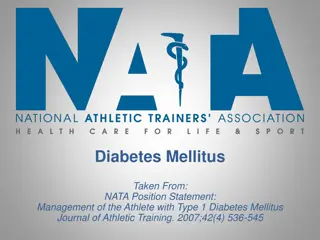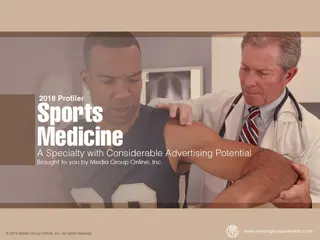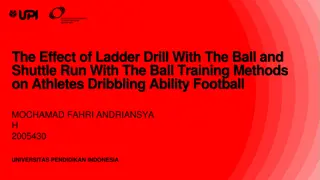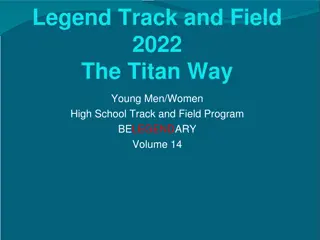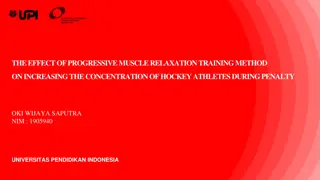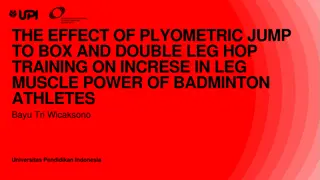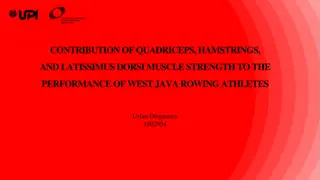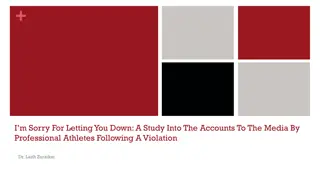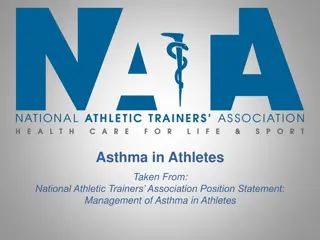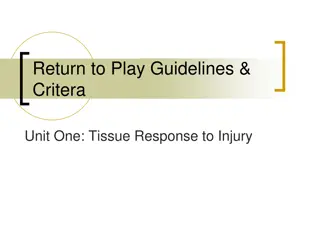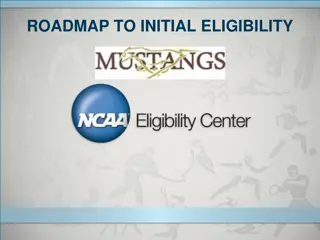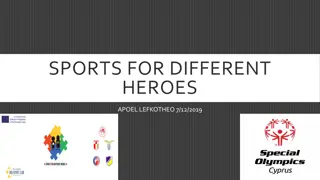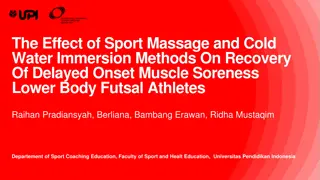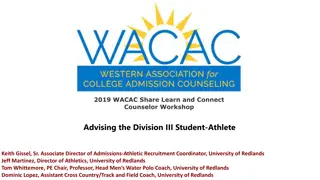Comprehensive Environmental Considerations for Athletes
This detailed guide covers essential environmental considerations for athletes, including exercising in various conditions, prevention of exertional heat illness, recognition of cold-related injuries, and risk factors for exertional heat illness. The provided recommendations help in preventing heat-related issues and ensuring the safety and well-being of athletes during training and competitions.
Download Presentation

Please find below an Image/Link to download the presentation.
The content on the website is provided AS IS for your information and personal use only. It may not be sold, licensed, or shared on other websites without obtaining consent from the author.If you encounter any issues during the download, it is possible that the publisher has removed the file from their server.
You are allowed to download the files provided on this website for personal or commercial use, subject to the condition that they are used lawfully. All files are the property of their respective owners.
The content on the website is provided AS IS for your information and personal use only. It may not be sold, licensed, or shared on other websites without obtaining consent from the author.
E N D
Presentation Transcript
Environmental Considerations Included are recommendations for: Exercising in hot and humid environments Recognition, treatment and prevention of exertional heat illness Acclimatization recommendations Heat index and usage Exercising in cold environments Recognition and prevention of cold-related injuries Wind chill factor table and usage Lightning safety and protocols
Exertional Heat Illness Prevention Identification of those athletes more predisposed or have previous history. (Insert list of particular student-athletes here as needed) Special considerations and modifications are needed for those wearing protective equipment during periods of high heat stress. Acclimatize athletes over a period of 7-14 days Educate athletes on prevention, recognition, treatment, risks, and how to pre-hydrate and rehydrate properly. Encourage proper sleeping, nutrition, dress and rest breaks to athletes. Weigh athletes to determine pre and post exercise weight to ensure proper rehydration. Check the conditions and develop guidelines and modifications for exercise based on the heat index. (insert specific institutional guidelines here as needed)
General Considerations of Risk Reduction Proper education of EHI for athletes, coaches, parents, medical staff, etc. Education on risk factors, hydration needs, acclimatization, work/rest ratios, signs and symptoms of EHI. Ensure a pre-participation physical examination that includes specific questions regarding fluid intake, weight changes during activity, medication and supplement use, and history of heat illnesses. Assure that onsite medical staff has authority to alter work/rest ratios, practice schedules, equipment worn, and removal of individuals from participation based upon the environment and or their medical condition. Insert specific on-site services provided by your institution here (staffing, equipment, locations of heat relief, etc.)
Risk Factors for EHI INTRINSIC FACTORS History of heat illness Inadequate heat acclimatization Higher percentage body fat Low fitness level Dehydration or over-hydration Presence of a fever Presence of gastrointestinal illness Salt Deficiency Skin Condition Ingestion of certain medications or supplements Motivation to push self/warrior mentality Reluctance to report problems, issues, illness, etc. EXTRINSIC FACTORS Intense or prolonged exercise with minimal breaks High temperature/humidity/ sun exposure Inappropriate work/rest ratios Lack of education and awareness of heat illness No emergency plan Limited duration and number of rest breaks Minimal access to fluids before and during practice and rest Delay in recognition of early warning signs Most of these risk factors are modifiable and are the means for preventing heat illness!
Dehydration When student-athletes do not replenish lost fluids they become dehydrated. Dehydration as minimal as 2% body weight loss (BWL) can hinder performance and thermoregulatory function. Recognition: Dry mouth, thirst, irritability, headache, weakness, dizziness, cramps, chills, vomiting, nausea, fatigue, decreased performance. Treatment: Move student-athlete to a cool environment and rehydrate. Rehydrate with a sports drink including carbohydrates and electrolytes, and sodium. Give student-athletes convenient access to fluids. A nauseated or vomiting student-athlete should seek medical attention to replace fluids via an intravenous line. Return to play considerations: If dehydration is minor and the student- athlete is symptom free, continued participation is acceptable.
Heat Cramps Heat (muscle) cramps tend to occur later in activity with muscle fatigue and after fluid and electrolyte imbalance and increased. Dehydration, diet poor in minerals, and large losses of sodium and other electrolytes increase the risk of severe often whole body muscle cramps. Recognition: Intense pain in muscles and persistent muscle contractions after prolonged exercise, most often with exercise in heat. Treatment: Regain normal hydration status and replace sodium losses via an electrolyte drink or other sodium source. Salty sweaters may need additional sodium earlier in activity. Light stretching, relaxation of involved muscles. Return to play Considerations: Student-athletes should be assessed to determine if they can return to participation. Diet, rehydration practices, electrolyte consumption, fitness status and level of acclimatization and use of dietary supplements should be assessed and possibly modified.
Heat Exhaustion Heat exhaustion is a moderate heat illness that occurs when the student- athlete continues physical activity after they start suffering from the ill effects of heat, like dehydration. The student-athletes body struggles to keep up with the demands, leading to heat exhaustion. Recognition: Physical fatigue, dehydration and or electrolyte depletion, coordination loss, fainting, dizziness, profuse sweating, pale skin, headache, nausea, vomiting, diarrhea, stomach/intestinal cramps, rapid recovery with treatment. Treatment: Remove student-athlete from play to a shaded or air conditioned area, remove excess clothing and equipment. Cool student-athlete with legs propped above heart level. If not nauseated, or vomiting rehydrate with chilled water or sports drink. If student-athlete cannot take fluids orally intravenous fluids are indicated. Transport to an emergency facility if rapid improvement is not noted with prescribed treatment. Return to play Considerations: Student-athlete should be symptom free and fully hydrated. Clearance from a physician or at least consultation with a physician is recommended. Underlying conditions or illness needs to be ruled out. Intense practice in heat should be avoided for at least one day. If lack of acclimatization or inadequate fitness level was the cause of illness, correct this before the student-athlete returns to full-intensity training in heat.
Exertional Heat Stroke Heat Stroke is a severe heat illness that occurs when a student-athlete s body created more heat than it can release, due to the strain of exercising in the heat. This results in a rapid increase in core body temperature, which can lead to permanent disability or even death if left untreated. Recognition: Increase in core body temperature, usually above 104 F. Central nervous system dysfunction(CNS) (altered consciousness, seizures, confusion, emotional instability irrational behavior or decreased mental acuity. Other indicators include: nausea, vomiting, diarrhea, headache, dizziness, weakness, hot and wet or dry skin, increased heart rate, decreased blood pressure or fast breathing, dehydration, and combativeness. Treatment: AGGRESSIVE AND IMMEDIATE whole body cooling. Cold water immersion (35 -38 F) within minutes is the best treatment until core temperature reaches 101 -102 F. Contact emergency medical services for transport. Monitor airway, breathing, circulation, core temperature, and CNS. If immersion is not possible use alternate methods such as spraying the body with cold water, fans, ice bags or cold towels (replaced frequently), and transport immediately to a medical facility. Return to play Considerations: Physician clearance is necessary before return to physical activity. The severity of the incident should designate the length of recovery time. The student-athlete should avoid exercise for the minimum of one week after release from medical care. Underlying conditions or illness needs to be ruled out. A gradual return to physical activity should begin under the supervision of an certified athletic trainer or other qualified medical professional.
Exertional Hyponatremia When a student-athlete consumes more fluids than necessary, and/or sodium lost in sweat is not adequately replaced, sodium in the bloodstream becomes diluted and can cause cerebral and/or pulmonary edema. Recognition: Possible symptoms include increasing headache, nausea, vomiting (often repetitive), swelling of extremities, irregular diet with inadequate sodium intake, copious urine with low specific gravity following exercise, lethargy/apathy, and agitation. If the condition progresses, CNS changes (altered consciousness, confusion, coma, convulsions, altered cognitive functioning). Treatment: Preventative methods to maintain proper sodium levels. Sodium intake via electrolyte drinks or other sources. If blood sodium levels cannot be determined onsite, hold off on rehydration and transport student-athlete to a medical facility. Return to play Considerations: Physician clearance is strongly recommended in all cases. In mild cases, activity can resume a few days after completing and educational session on establishing and individual- specific hydration protocol.
Tips for Coaches and Student-Athletes Coaches and Administrators Student-Athletes Stay hydrated. Hydrate properly before, during and after exercise. Know that nutritional supplements especially those with caffeine can have a negative impact on hydration and or increase metabolism and heat production. Know that certain medications can have similar effects as supplements, e.g. antihistamines, decongestants, certain asthma medication, Ritalin, diuretics and alcohol. Know the signs and symptoms of heat illness and report them. Be aware of temperature and humidity levels. Change practice length, intensity and equipment use as the levels rise. Remind student-athletes to drink regularly. Schedule frequent fluid breaks and increase the frequency as heat and humidity levels rise. Know the signs and symptoms of heat illness and get student-athletes checked out by medical staff. Have an emergency action plan for obtaining medical services and know the plan and how to carry it out.
Heat Acclimatization Recommendations NCAA Football: Allow a 14 day heat acclimatization period prior to full-scale athletic participation Day 1-5: only 1 practice/day If interrupted by weather or heat, practice begin once safe but total time does not exceed 3 hrs. 1 hr. walk-through permitted, but need at least 3 hr. recovery between practice and walk-through Day 1, 2: Only helmet worn. Day 3-5: Only helmet and shoulder pads. Day 6-14: All protective equipment and full contact can begin Two-a-day practices now discontinued. A second session may include walkthroughs or meetings but no helmets, pads or conditioning All sessions must be separated by a 3 hr. recovery time. Time spent receiving medical treatment and eating meals may be included as part of the recovery time. Multiple practice sessions should not exceed 3 hours, and athletes should not participate in more than 5 total hours in one day. Warm-up, stretching, cool down, walk-through, conditioning, weight lifting are included.
Recognition of Cold-Related Injuries Monitor closely and initiate gradual re-warming if any of these signs or symptoms are present: Dry, waxy skin, edema, burning or tingling sensation, skin is white, gray, black or purple, blood blistering, itching skin, loss of sensation, increased temperature. Vigorous shivering, pallor, nose bleeds. Seek medical attention if any of these signs or symptoms are present: Amnesia, depressed respiration, slurred speech, impaired mental function, dilated pupils, muscle rigidity, coma.
Prevention of cold-related injuries Perform thorough pre-participation screening to ID those more predisposed or have previous history. Have medical care on site that are familiar with cold related injuries. Educate athletes on prevention, recognition, treatment, and risks involved. Encourage proper sleeping, nutrition, and rest breaks to athletes. Develop event and practice guidelines for participating in cold conditions using wind chill factors. Proper dress: Internal layer evaporates but not absorbs sweat, the middle layer insulates and the external layer should be water and wind resistant. Provide athletes opportunities to rewarm or stay warm throughout practice/competition. Include warming supplies: water and rehydration, heat packs, blankets, heaters, and a warm tub if possible.
30 and below: Be aware of potential for cold injury 25 and below: provide additional clothing, cover as much as possible and facilitate rewarming. 15 and below: consider modifying activity to limit exposure 0 and below: Consider terminating or rescheduling activity
Lightning Safety Formalize a EAP specific to lightning safety. Identify a designated weather watcher and/or check weather updates. Establish a chain of command (Insert names/positions of institutional personnel who has the authority/responsibility to suspend game, practice, etc.) Develop Criteria for Postponement and Resumption of Activities. Be conservative and stick to procedures, even if it s not raining. Understand the qualifications of safe structures, and know where they are in relation to each athletic field. Safe: Fully enclosed building with plumbing, electric wiring or fully enclosed vehicle with metal roof and windows up. (don t touch any metal while in car) Unsafe: in golf carts, under trees, indoor swimming pools, showering in a substantial building, under picnic areas, in storage sheds, and open fields. Insert recommended institutional shelters in case of inclement weather
Lightning Safety Use the Flash to bang 30 30 rule of deciding when to suspend activities. Because lightning can strike up to 10 miles from a storm, you should seek safe shelter as soon as you hear thunder or see lightning. Suspend activity and move to a safe location if the time between the lightning flash and the rumble of thunder is 30 seconds or less. Wait until the last bang hasn t been heard for at least 30 minutes. To estimate the distance between your location and a lightning flash, use the "Flash to Bang" method: If you observe lightning, count the number of seconds until you hear thunder. Divide the number of seconds by five to obtain the distance in miles. Example: If you see lightning and it takes 10 seconds before you hear the thunder, then the lightning is 2 miles away. If Thunder is heard 5 seconds after a Flash 10 seconds after a Flash 15 seconds after a Flash 20 seconds after a Flash 25 seconds after a Flash 30 seconds after a Flash 35 seconds after a Flash 40 seconds after a Flash The Lightning is... 1 mile away 2 miles away 3 miles away 4 miles away 5 miles away 6 miles away 7 miles away 8 miles away
Lightning Safety Consider Large-Venue Planning Management: Assume lightning position if shelter can t be found immediately. (Feet together, squat on ground with hands covering ears.) Make sure it s safe before helping, first move the victim to a safe location. Maintain CPR and standard first-aid certification. May appear dead but need CPR and recue breathing.
References National Athletic Trainers Association Position Statement: Exertional Heat Illnesses (2015) https://www.nata.org/practice-patient-care/health-issues/heat-illness National Athletic Trainers Association consensus statement (2003) https://www.nata.org/sites/default/files/inter-association-task-force-exertional-heat-illness.pdf National Athletic Trainers Association Position Statement: Environmental Cold Injuries (2008) http://natajournals.org/doi/pdf/10.4085/1062-6050-43.6.640 National Weather Service http://www.nws.noaa.gov/om/windchill http://www.nws.noaa.gov/os/heat/index.shtml#heatindex National Athletic Trainers Association Position Statement: Lightning Safety for Athletics and Recreation (2013) http://natajournals.org/doi/pdf/10.4085/1062-6050-48.2.25 Korey Stringer Institute. http://ksi.uconn.edu/prevention/heat-acclimatization/ NCAA Sports Medicine Handbook 2014-2015 http://www.ncaapublications.com/productdownloads/MD15.pdf CDC https://www.cdc.gov/nceh/hsb/extreme/Heat_Illness/index.html
